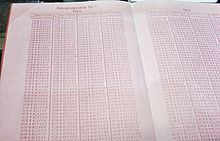54:
65:
The transmission of radio messages had the potential risks of revealing the submarine's presence and direction; if decoded the content was also revealed. Submarines need to provide information, mostly in standard form (position of convoy to attack and of submarine, weather information), to their
102:
on 9 May 1941. In August 1941, Dönitz began addressing U-boats by the names of their commanders, instead of boat numbers. The method of defining U-boat meeting points in the Short Signal Book was regarded as compromised, so a method was defined by
90:
code was intended to shorten transmission time to below the time required to get a directional fix. It was not primarily intended to hide signal contents; protection was intended to be achieved by encoding with the Enigma machine. A copy of the
139:
was then encoded with the Enigma machine and subsequently transmitted as rapidly as possible, typically taking about 20 seconds. Typical length of an information or weather signal was about 25 characters.
134:
code system condensed messages into short codes consisting of short sequences for common terms such as "convoy location" so that additional descriptions would not be needed in the message. The resulting
350:
355:
335:
340:
345:
304:
221:
66:
bases. Initially Morse code transmissions could be used. To inhibit detection, the duration of messages needed to be minimised; for this,
74:. To shorten transmission even further, the message could be sent by a fast machine instead of a human radio operator. For example, the
78:– not implemented in time – decreased the time to send a Morse dot from around 50 milliseconds for a human to 1 millisecond.
143:
Conventional RDF needed about a minute to fix the bearing of a radio signal, and the
Kurzsignale protected against this. However, the
162:
262:
165:
and, if deployed, would have been a serious setback for Allied anti-submarine and code-breaking activities. By late 1944 the
96:
111:
275:
123:
184:
330:
325:
179:
205:
238:
151:
300:
296:
289:
256:
217:
251:(The article gives full details and examples of Kurzsignale and Wetterkurzschlüssel encoding)
161:
in not more than 460 milliseconds; this was short enough to prevent location even by
30:
71:
70:
short-coding was used. To prevent interception, messages needed to be encrypted by the
58:
319:
75:
127:
107:
42:
38:
169:
program was a top priority, but the war ended before the system was operational.
147:
system which was in use by the Allies could cope with these short transmissions.
114:(German:Gradnetzmeldeverfahren) was introduced and used until the end of the war
53:
213:
144:
104:
210:
Seizing the Enigma – The Race to Break the German U-Boat codes 1939–1943
57:
The short signal booklet was printed with water-soluble red ink on pink
177:
A similar coding system was used for weather reports from U-boats, the
291:
Battle of Wits: The
Complete Story of Codebreaking in World War II
52:
61:, in order to be able to destroy it quickly in case of danger.
18:
Code system used by the German Navy during World War II
183:(Short Weather Cipher). Code books were captured from
130:
developed various systems to speed up broadcast. The
45:to minimize the transmission duration of messages.
288:
276:Aircraft of World War II: thread August 19, 1942
110:to disguise their positions on the Kriegsmarine
351:Military history of Germany during World War II
8:
157:, in testing from August 1944, could send a
356:World War II military equipment of Germany
336:History of telecommunications in Germany
197:
37:), was a short code system used by the
254:
216:: Naval Institute Press. p. 237.
295:. New York, NY: Free Press. pp.
7:
341:Signals intelligence of World War II
346:Military communications of Germany
14:
122:Aware of the danger presented by
239:"Kurzsignale on German U-boats"
243:Cipher Machines and Cryptology
1:
95:code book was captured from
287:Budiansky, Stephen (2000).
372:
261:: CS1 maint: postscript (
112:German Naval Grid System
124:radio direction finding
118:Radio direction finding
97:German submarine
62:
34:
56:
41:(German Navy) during
189:on 30 October 1942.
173:Short Weather cipher
150:The fully automated
25:, also known as the
180:Wetterkurzschlüssel
237:Rijmenants, Dirk.
152:burst transmission
63:
306:978-0-684-85932-3
223:978-1-59114-807-4
82:Short Signal book
27:Short Signal Book
23:Short Signal Code
363:
311:
310:
294:
284:
278:
273:
267:
266:
260:
252:
250:
249:
234:
228:
227:
202:
371:
370:
366:
365:
364:
362:
361:
360:
316:
315:
314:
307:
286:
285:
281:
274:
270:
253:
247:
245:
236:
235:
231:
224:
204:
203:
199:
195:
175:
120:
84:
51:
19:
12:
11:
5:
369:
367:
359:
358:
353:
348:
343:
338:
333:
328:
318:
317:
313:
312:
305:
279:
268:
229:
222:
208:(2012-01-01).
196:
194:
191:
174:
171:
119:
116:
83:
80:
72:Enigma machine
59:blotting paper
50:
47:
35:Kurzsignalbuch
17:
13:
10:
9:
6:
4:
3:
2:
368:
357:
354:
352:
349:
347:
344:
342:
339:
337:
334:
332:
329:
327:
324:
323:
321:
308:
302:
298:
293:
292:
283:
280:
277:
272:
269:
264:
258:
244:
240:
233:
230:
225:
219:
215:
211:
207:
201:
198:
192:
190:
188:
187:
182:
181:
172:
170:
168:
164:
160:
156:
155:Kurier system
153:
148:
146:
141:
138:
133:
129:
125:
117:
115:
113:
109:
108:cryptanalysts
106:
101:
100:
94:
89:
81:
79:
77:
76:Kurier system
73:
69:
60:
55:
48:
46:
44:
40:
36:
32:
28:
24:
16:
331:Cryptography
326:Kriegsmarine
290:
282:
271:
246:. Retrieved
242:
232:
209:
200:
185:
178:
176:
166:
158:
154:
149:
142:
136:
131:
128:Kriegsmarine
121:
98:
92:
87:
85:
67:
64:
43:World War II
39:Kriegsmarine
26:
22:
20:
15:
206:Kahn, David
132:Kurzsignale
126:(RDF), the
93:Kurzsignale
88:Kurzsignale
68:Kurzsignale
49:Description
320:Categories
248:2016-11-21
193:References
159:Kurzsignal
137:Kurzsignal
214:Annapolis
163:huff-duff
145:huff-duff
257:cite web
105:B-Dienst
297:341–343
303:
220:
167:Kurier
31:German
186:U-559
99:U-110
301:ISBN
263:link
218:ISBN
86:The
21:The
322::
299:.
259:}}
255:{{
241:.
212:.
33::
309:.
265:)
226:.
29:(
Text is available under the Creative Commons Attribution-ShareAlike License. Additional terms may apply.
